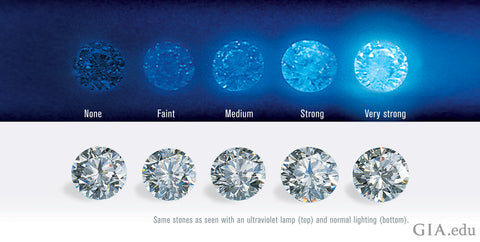Can an average person tell the difference between diamonds that do and don’t fluoresce?
GIA has studied the effect of blue fluorescence on diamond appearance. The Institute screened a large number of diamonds, assembling four sets of six diamonds, with each group representing a different color grade (E, G, I, and K). The diamonds in each set were as similar as possible in all respects except the intensity of blue fluorescence. Diamond graders, trained professionals, and average observers viewed the diamonds in controlled conditions to make a judgment about their appearance.
Here is what GIA found: “For the average observer, meant to represent the jewelry buying public, no systematic effects of blue fluorescence on the face-up appearance of the groups of diamonds were detected. Even experienced observers did not consistently agree on the effects of fluorescence from one stone to the next.”

Simply put, blue fluorescence had a negligible effect on the face-up appearance of diamonds in the colorless or near-colorless grade ranges (grades D through J) except for a slight improvement in the rare instances of very strong fluorescence intensity.

GIA answers, “Is diamond fluorescence good or bad?”
Fluorescence is neither good nor bad. A diamond’s beauty is in the eye of the beholder. You may perceive fluorescence, or you may not. You may like it, or you may not.


